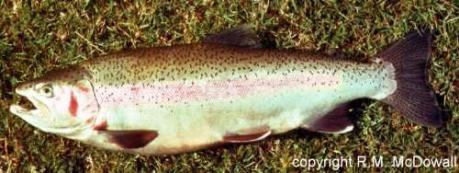Rainbow trout
Oncorhynchus mykiss (Walbaum, 1792)

Rainbow trout are native to the westward draining rivers of North America and also to the Kamchatka Peninsula on the western side of the Pacific Ocean. Stock introduced into New Zealand were brought from North America as early as 1883. Although they were not as easy to establish as brown trout, self-sustaining populations of rainbow trout are now widespread in New Zealand and form the backbone of the popular and highly valued fisheries that occur in the lakes and rivers of the central North Island. They also support fisheries in many of the lakes along the eastern flanks of the Southern Alps in the South Island.
Like other salmonids, the colour pattern of rainbow trout is variable. Lake-dwelling fish are generally uniformly silver with small, darker spots along the back, mainly above the lateral line. The backs of river dwelling fish are often more olive-green, and the red band, or rainbow, along the lateral line more prominent. When rainbow trout move into rivers and streams for spawning, this band intensifies in colour, and red slashes may occur on the cheeks and in the folds beneath the lower jaw.
Rainbow trout can be distinguished from brown trout and Atlantic salmon by the presence of dark spots on the caudal (tail) fin, and from brook char and mackinaw by the absence of pale spots on their sides. Rainbow trout have a short-based anal fin compared to a long-based anal fin on sockeye salmon. Spawning chinook salmon also develop a red flush along their sides and hence can be confused with rainbow trout. However, chinook salmon have black gums whereas the mouth of rainbow trout is pale in colour.
Most rainbow trout migrate to their spawning grounds, with both lake and river dwelling fish moving upstream to suitable locations, often in small tributaries. Here they may congregate in large schools just prior to spawning. In lakes without suitable spawning tributaries, spawning can occur along the lakeshore. The main spawning season for rainbow trout is June and July, but the season can be extended to October in some lakes, especially those in the colder regions of the North Island.
Although there are no sea-run populations of rainbow trout in New Zealand (usually very large fish known in North American as steelhead), fish 500–600 mm in length and 2–3 kg in weight are the norm in most New Zealand populations. In lakes regarded as trophy fisheries, fish of 4–5 kg are caught regularly.
![Rainbow trout distribution map [2024]](/sites/default/files/styles/wide/public/2024-02/Rainbow%20trout.jpeg?itok=nl7GwddR)


